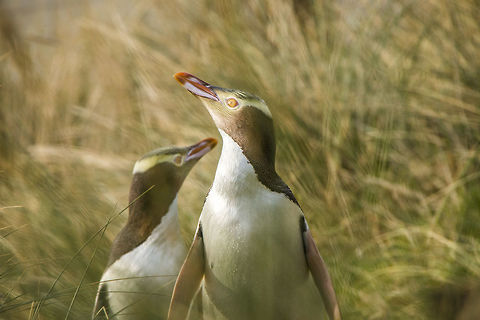
Appearance
This is a mid-sized penguin, measuring 62–79 cm long . Weights vary through the year being greatest, 5.5 to 8 kg , just before moulting and least, 3 to 6 kg , after moulting. The males are larger than the females. It has a pale yellow head and paler yellow iris with black feather shafts. The chin and throat are brownish-black. There is a band of bright yellow running from its eyes around the back of the head. The juvenile has a greyer head with no band and their eyes have a grey iris.The yellow-eyed penguin may be long lived, with some individuals reaching 20 years of age. Males are generally longer lived than females, leading to a sex ratio of 2:1 around the age of 10–12 years.
Distribution
This penguin usually nests in forest or scrub, among native flax and lupin , on slopes or gullies, or the shore itself, facing the sea. These areas are generally sited in small bays or on headland areas of larger bays. It is found in New Zealand, on the south-east coast of the South Island most notably on Otago Peninsula, Foveaux Strait, Stewart Island, and sub-Antarctic islands of Auckland and Campbell Islands. It expanded its range from the sub-Antarctic islands to the main islands of New Zealand after the extinction of the Waitaha penguin several hundred years ago.Status
This species of penguin is endangered, with an estimated population of 4000. It is considered one of the world's rarest penguin species. The main threats include habitat degradation and introduced predators. It may be the most ancient of all living penguins.A reserve protecting more than 10% of the mainland population was established at Long Point in the Catlins in November 2007 by the Department of Conservation and the Yellow-eyed Penguin Trust.
In August 2010, the yellow-eyed penguin was granted protection under the U.S. Endangered Species Act.
Behavior
The yellow-eyed penguin forages predominantly over the continental shelf between 2 km and 25 km offshore, diving to depths of 40 m to 120 m Breeding penguins usually undertake two kinds of foraging trips: day trips where the birds leave at dawn and return in the evening ranging up to 25 km from their colonies, and shorter evening trips during which the birds are seldom away from their nest longer than four hours or range farther than 7 km. Yellow-eyed penguins are known to be an almost exclusive benthic forager that searches for prey along the seafloor. Accordingly, up to 90% of their dives are benthic dives. This also means that their average dive depths are determined by the water depths within their home ranges.Habitat
This penguin usually nests in forest or scrub, among native flax and lupin , on slopes or gullies, or the shore itself, facing the sea. These areas are generally sited in small bays or on headland areas of larger bays. It is found in New Zealand, on the south-east coast of the South Island most notably on Otago Peninsula, Foveaux Strait, Stewart Island, and sub-Antarctic islands of Auckland and Campbell Islands. It expanded its range from the sub-Antarctic islands to the main islands of New Zealand after the extinction of the Waitaha penguin several hundred years ago.Reproduction
Whether yellow-eyed penguins are colonial nesters has been an ongoing issue with zoologists in New Zealand. Most Antarctic penguin species nest in large high density aggregations of birds. For an example see the photo of nesting emperor penguin. In contrast yellow-eyed penguins do not nest within visual sight of each other. While they can be seen coming ashore in groups of four to six or more individuals then disperse along track to individual nests sites out of sight of each other. The consensus view of New Zealand penguin workers is that it is preferable to use habitat rather than colony to refer to areas where yellow-eyed penguins nest. Nest sites are selected in August and normally two eggs are laid in September. The incubation duties are shared by both parents who may spend several days on the nest at a time. For the first six weeks after hatching, the chicks are guarded during the day by one parent while the other is at sea feeding. The foraging adult returns at least daily to feed the chicks and relieve the partner.After the chicks are six weeks of age, both parents go to sea to supply food to their rapidly growing offspring. Chicks usually fledge in mid-February and are totally independent from then on. Chick fledge weights are generally between 5 and 6 kg.
First breeding occurs at three to four years of age and long term partnerships are formed.
Food
Around 90% of the yellow-eyed penguin's diet is made up of fish, chiefly demersal species that live near the seafloor , red cod , opalfish ). Other species taken are New Zealand blueback sprat and cephalopods such as arrow squid .Cultural
*The hoiho appears on the reverse side of the New Zealand five-dollar note.⤷ The yellow-eyed penguin is the mascot to Dunedin City Council's recycling and solid waste management campaign.
⤷ The yellow-eyed penguin is also featured in ''Farce of the Penguins'', in which they complain about global warming.
References:
Some text fragments are auto parsed from Wikipedia.